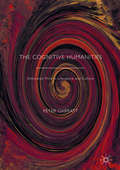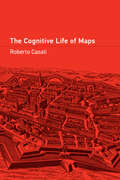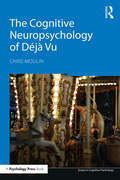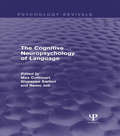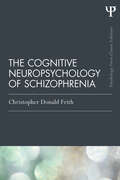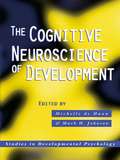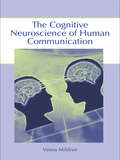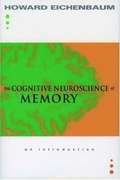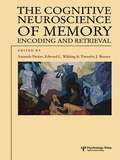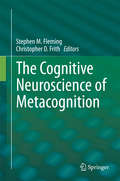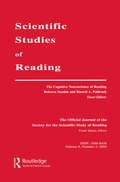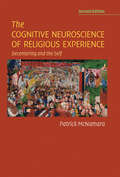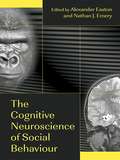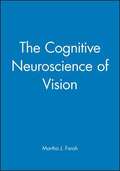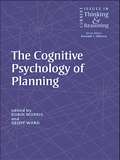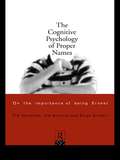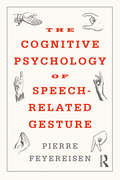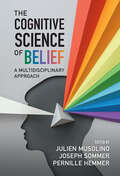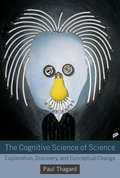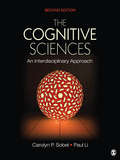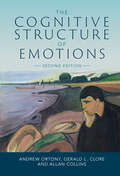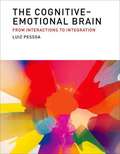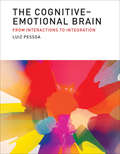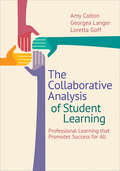- Table View
- List View
The Cognitive Humanities: Embodied Mind in Literature and Culture
by Peter GarrattThis book identifies the ‘cognitive humanities’ with new approaches to literature and culture that engage with recent theories of the embodied mind in cognitive science. If cognition should be approached less as a matter of internal representation—a Cartesian inner theatre—than as a form of embodied action, how might cultural representation be rethought? What can literature and culture reveal or challenge about embodied minds? The essays in this book ask what new directions in the humanities open up when the thinking self is understood as a participant in contexts of action, even as extended beyond the skin. Building on cognitive literary studies, but engaging much more extensively with ‘4E’ cognitive science (embodied, embedded, enactive, extended) than previously, the book uses case studies from many different historical settings (such as early modern theatre and digital technologies) and in different media (narrative, art, performance) to explore the embodied mind through culture.
The Cognitive Life of Maps
by Roberto CasatiThe &“mapness of maps&”—how maps live in interaction with their users, and what this tells us about what they are and how they work.In a sense, maps are temporarily alive for those who design, draw, and use them. They have, for the moment, a cognitive life. To grapple with what this means—to ask how maps can be alive, and what kind of life they have—is to explore the core question of what maps are. And this is what Roberto Casati does in The Cognitive Life of Maps, in the process assembling the conceptual tools for understanding why maps have the power they have, why they are so widely used, and how we use (and misuse) them.Drawing on insights from cognitive science and philosophy of mind, Casati considers the main claims around what maps are and how they work—their specific syntax, peculiar semantics, and pragmatics. He proposes a series of steps that can lead to a precise theory of maps, one that reveals what maps have in common with diagrams, pictures, and texts, and what makes them different. This minimal theory of maps helps us to see maps nested in many cognitive artifacts—clock faces, musical notation, writing, calendars, and numerical series, for instance. It also allows us to tackle the issue of the territorialization of maps—to show how maps can be used to draw specific spatial inferences about territories. From the mechanics of maps used for navigation to the differences and similarities between maps and pictures and models, Casati's ambitious work is a cognitive map in its own right, charting the way to a new understanding of what maps mean.
The Cognitive Neuropsychology of Déjà Vu (Essays in Cognitive Psychology)
by Chris MoulinDéjà vu is one of the most complex and subjective of all memory phenomena. It is an infrequent and striking mental experience, where the feeling of familiarity is combined with the knowledge that this feeling is false. While until recently it was an aspect of memory largely overlooked by mainstream cognitive psychology, this book brings together the growing scientific literature on déjà vu, making the case for it as a metacognitive phenomenon. The Cognitive Neuropsychology of Déjà Vu reviews clinical, experimental and neuroimaging methods, focusing on how memory disorders and neurological dysfunction relate to the experience. Examining déjà vu as a memory phenomenon, Chris Moulin explores how the experience of déjà vu in special populations, such as healthy aging or those with schizophrenia, provides new insights into understanding this phenomenon. He considers the extensive data on déjà vu in people with epilepsy, dementia and other neurological conditions, assessing neuropsychological theories of déjà vu formation. Essential reading for all students and researchers interested in memory disorders, this valuable book presents the case for déjà vu as a ‘healthy’ phenomenon only experienced by people with sufficient cognitive resources to oppose and detect the false feeling of familiarity.
The Cognitive Neuropsychology of Language (Psychology Revivals)
by Max Coltheart Giuseppe Sartori Remo JobDamage to the brain can impair language in many different ways, severely harming some linguistic functions whilst sparing others. To achieve some understanding of the apparently bewildering diversity of language disorders, it is necessary to interpret impaired linguistic performance by relating it to a model of normal linguistic performance. Originally published in 1987, this book describes the application of such models of normal language processing to the interpretation of a wide variety of linguistic disorders. It deals with both the production and the comprehension of language, with language at both the sentence and the single-word level, with written as well as with spoken language and with acquired as well as with developmental disorders.
The Cognitive Neuropsychology of Schizophrenia (Psychology Press & Routledge Classic Editions)
by Christopher Donald FrithThis is a classic edition of Christopher Frith’s award winning book on cognitive neuropsychology and schizophrenia, which now includes a new introduction from the author. The book explores the signs and symptoms of schizophrenia using the framework of cognitive neuropsychology, looking specifically at the cognitive abnormalities that underlie these symptoms. The book won the British Psychological Society book award in 1996, and is now widely seen as a classic in the field of brain disorders. The new introduction sees the author reflect on the influence of his research and the subsequent developments in the field, more than 20 years since the book was first published.
The Cognitive Neuroscience of Development: The Role Of Experience And The Developing Brain (Studies in Developmental Psychology)
by Michelle De Haan Mark H. JohnsonHow are the experiences of childhood incorporated into the structures of the developing brain, and how do these changes in the brain influence behaviour? This is one of the many questions motivating research in the relatively new field of developmental cognitive neuroscience. This book provides an extensive overview of the methods used to study such questions, and a thorough investigation into the emerging interface between neurobiological and psychological perspectives in the study of typical and atypical cognitive behaviour. The Cognitive Neuroscience of Development is a collection of essays written by international experts in the field. It covers not only traditional topics such as language, attention and memory development, but also includes individual chapters covering the theories of neurocognitive development and methods of studying brain activity in young infants and children. There are additional chapters on hormonal influences on brain and behavioural development, gender differences in the brain, and genetic disorders.This exceptional series of contributions surveys the study of both cognitive and neural development. The book takes into account brain architecture as well as the behavioural context of development, thus it succeeds in integrating the multiple methods and domains of research that have previously been studied in a more fragmented way. It will be invaluable to upper level students as well as researchers and teachers in Psychology, Neuroscience, Cognitive Science, Paediatrics and related fields.
The Cognitive Neuroscience of Human Communication
by Vesna MildnerThis is a book about speech and language. It is primarily intended for those interested in speech and its neurophysiological bases: phoneticians, linguists, educators, speech therapists, psychologists, and neuroscientists. Although speech and language are its central topic, it provides information about related topics as well (e.g. structure and functioning of the central nervous system, research methods in neuroscience, theories and models of speech production and perception, learning, and memory). Data on clinical populations are given in parallel with studies of healthy subjects because such comparisons can give a better understanding of intact and disordered speech and language functions. There is a review of literature (more than 600 sources) and research results covering areas such as neuroanatomy, neurophysiology, development of the nervous system, sex differences, history of neurolinguistics, behavioral, neuroimaging and other research methods in neuroscience, linguistics and psychology, theories and models of the nervous system function including speech and language processing, kinds of memory and learning and their neural substrates, critical periods, various aspects of normal speech and language processes (e.g. phonetics, phonology, syntax, semantics, reading), bilingualism, speech and language disorders, and many others. Newcomers to the field of neurolinguistics will find it as readable as professionals will because it is organized in a way that gives the readers flexibility and an individual approach to the text. The language is simple but all the technical terms are provided, explained, and illustrated. A comprehensive glossary provides additional information.
The Cognitive Neuroscience of Memory: An Introduction
by Howard EichenbaumThis clear and accessible textbook introduces students to the brain's remarkable capacity for memory.
The Cognitive Neuroscience of Memory: Encoding and Retrieval (Studies in Cognition)
by Amanda Parker Edward L. Wilding Timothy J. BusseyRecent advances in techniques available to memory researchers have led to a rapid expansion in the field of cognitive neuroscience of memory. This book provides accessible coverage of four key areas of recent advance, including research on functional imaging, electrophysiological and lesion studies, and developments from the computational modelling approach.The first section reviews functional imaging studies in humans, with particular emphasis on how imaging methods have clarified the cortical areas involved in memory formation and retrieval. The second section describes electrophysiological and lesion research in monkeys, where lesion and disconnection studies are rapidly adding to our knowledge of both information processing and modulatory aspects of memory formation. In the third section, electrophysiological and lesion studies in rats are reviewed allowing for a detailed study of the role of novelty and exploration in memory formation. The final section reviews current research in computational modelling which has allowed the development of new theoretical and experimental approaches to the study of memory encoding and retrieval.This volume draws together the current developments in each field, allowing the synthesis of ideas and providing converging evidence from a range of sources. It will be a useful resource for both advanced undergraduate and postgraduate students of psychology, as well as researchers in the field and anyone with an interest in cognitive neuroscience.
The Cognitive Neuroscience of Metacognition
by Stephen M. Fleming Christopher D. FrithMetacognition is the capacity to reflect upon and evaluate cognition and behaviour. Long of interest to philosophers and psychologists, metacognition has recently become the target of research in the cognitive neurosciences. By combining brain imaging, computational modeling, neuropsychology and insights from psychiatry, the present book offers a picture of the metacognitive functions of the brain. Chapters cover the definition and measurement of metacognition in humans and non-human animals, the computational underpinnings of metacognitive judgments the cognitive neuroscience of self-monitoring ranging from confidence to error-monitoring and neuropsychiatric studies of disorders of metacognition. This book provides an invaluable overview of a rapidly emerging and important field within cognitive neuroscience.
The Cognitive Neuroscience of Reading: A Special Issue of scientific Studies of Reading
by Russell A. Poldrack Rebecca SandakThis special issue of Scientific Studies of Reading highlights the great deal of progress that has been made recently in understanding the neurobiological foundations of basic processes in reading. The papers demonstrate how functional neuroimaging techniques have provided novel insights into how reading works in the brain, and how these processes may be disorganized in reading disorders. Importantly, they illustrate that understanding how reading works in the brain is not a simple end-goal, but rather reveals new phenomena that will serve to constrain theories of reading. Although these articles make clear that full understanding of these processes is well off in the distance, the editors hope that they will inspire further collaboration between reading researchers and neuroscientists.
The Cognitive Neuroscience of Religious Experience: Decentering and the Self
by Patrick McNamaraThe Cognitive Neuroscience of Religious Experience, now updated and expanded in a new edition, updates key topics covered in the first edition including: decentering and self-transformation, supernatural agent cognitions, mystical states, religious language, ritualization, and religious group agency. It expands upon the first edition to include major findings on brain and religious experience over the past decade, focusing on methodology, future thinking, and psychedelics. It provides an up-to-date review of brain-based accounts of religious experiences, and systematically examines the rationale for utilizing neuroscience approaches to religion. While it is primarily intended for religious studies scholars, people interested in comparative religion, philosophy of religion, cultural evolution, and personal self-transformation will find an account of how such transformation is accomplished within religious contexts.
The Cognitive Neuroscience of Social Behaviour
by Alexander Easton Nathan J. EmeryThe potential for cognitive neuroscience to shed light on social behaviour is increasingly being acknowledged and is set to become an important new approach in the field of psychology. Standing at the vanguard of this development, The Cognitive Neuroscience of Social Behaviour provides a state-of-the-art contribution to a subject still in its infancy. Divided into three parts, the book presents an overview of research into neural substrates of social interactions, the cognitive neuroscience of social cognition and human disorders of social behaviour and cognition.
The Cognitive Neuroscience of Vision (Fundamentals of Cognitive Neuroscience)
by Martha J. FarahThe Cognitive Neuroscience of Vision begins by introducing the reader to the anatomy of the eye and visual cortex and then proceeds to discuss image and representation, face recognition, printed word recognition, visual sematic memory and visual attention and perception.
The Cognitive Psychology of Planning (Current Issues in Thinking and Reasoning)
by Geoff Ward Robin MorrisThe Cognitive Psychology of Planning assesses recent advances in the scientific study of the cognitive processes involved in formulating, evaluating and selecting a sequence of thoughts and actions to achieve a goal. Approaches discussed range from those which look at planning in terms of problem-solving behaviour to those which look at how we control thoughts and actions within the frameworks of attention, working memory or executive function. Topics covered include: simple to complex tasks, well- and ill-defined problems and the effects of age and focal brain damage on planning. This survey of recent work in the cognitive psychology and cognitive neuropsychology of planning will be an invaluable resource for anyone studying or researching in the fields of thinking and reasoning, memory and attention.
The Cognitive Psychology of Proper Names: On The Importance Of Being Ernest
by Tim Valentine Serge Bredart Tim BrennenIt's on the tip of my tongue, but I can't remember her name." Lots of people have difficulty remembering people's names, even though they can easily recall other information about the person. As memory and retrieval processes are central to cognitive psychology and neuropsychology the study of proper names makes a fascinating and practical focus of study. Using an information processing approach, Valentine, Brennen and Bredart consider evidence from speech production, face recognition and word recognition to develop a new functional model of the production and recognition of people's names. This book will be valuable to all those studying cognitive psychology, cognitive neuropsychology and linguistics. It makes a suitalbe text for higher level undergraduates and postgraduates and those engaged in research.
The Cognitive Psychology of Speech-Related Gesture
by Pierre FeyereisenWhy do we gesture when we speak? The Cognitive Psychology of Speech-Related Gesture offers answers to this question while introducing readers to the huge interdisciplinary field of gesture. Drawing on ideas from cognitive psychology, this book highlights key debates in gesture research alongside advocating new approaches to conventional thinking. Beginning with the definition of the notion of communication, this book explores experimental approaches to gesture production and comprehension, the possible gestural origin of language and its implication for brain organization, and the development of gestural communication from infancy to childhood. Through these discussions the author presents the idea that speech-related gestures are not just peripheral phenomena, but rather a key function of the cognitive architecture, and should consequently be studied alongside traditional concepts in cognitive psychology. The Cognitive Psychology of Speech Related Gesture offers a broad overview which will be essential reading for all students of gesture research and language, as well as speech therapists, teachers and communication practitioners. It will also be of interest to anybody who is curious about why we move our bodies when we talk.
The Cognitive Science of Belief: A Multidisciplinary Approach
by Julien Musolino Joseph Sommer Pernille HemmerBeliefs play a central role in our lives. They lie at the heart of what makes us human, they shape the organization and functioning of our minds, they define the boundaries of our culture, and they guide our motivation and behavior. Given their central importance, researchers across a number of disciplines have studied beliefs, leading to results and literatures that do not always interact. The Cognitive Science of Belief aims to integrate these disconnected lines of research to start a broader dialogue on the nature, role, and consequences of beliefs. It tackles timeless questions, as well as applications of beliefs that speak to current social issues. This multidisciplinary approach to beliefs will benefit graduate students and researchers in cognitive science, psychology, philosophy, political science, economics, and religious studies.
The Cognitive Science of Science: Explanation, Discovery, and Conceptual Change (Handbook Of The Philosophy Of Science Ser.)
by Paul ThagardA cognitive science perspective on scientific development, drawing on philosophy, psychology, neuroscience, and computational modeling.Many disciplines, including philosophy, history, and sociology, have attempted to make sense of how science works. In this book, Paul Thagard examines scientific development from the interdisciplinary perspective of cognitive science. Cognitive science combines insights from researchers in many fields: philosophers analyze historical cases, psychologists carry out behavioral experiments, neuroscientists perform brain scans, and computer modelers write programs that simulate thought processes.Thagard develops cognitive perspectives on the nature of explanation, mental models, theory choice, and resistance to scientific change, considering disbelief in climate change as a case study. He presents a series of studies that describe the psychological and neural processes that have led to breakthroughs in science, medicine, and technology. He shows how discoveries of new theories and explanations lead to conceptual change, with examples from biology, psychology, and medicine. Finally, he shows how the cognitive science of science can integrate descriptive and normative concerns; and he considers the neural underpinnings of certain scientific concepts.
The Cognitive Sciences: An Interdisciplinary Approach
by Carolyn P. Sobel Paul LiThe Cognitive Sciences: An Interdisciplinary Approach, Second Edition offers an engaging, thorough introduction to the cognitive sciences. Authors Carolyn Sobel and Paul Li examine the historical and contemporary issues and research findings of the core cognitive science disciplines: cognitive psychology, neuroscience, artificial intelligence, linguistics, evolutionary psychology, and philosophy. For each of these core disciplines, the historical development and classic research studies are presented in one chapter and current research development and issues follow in a second chapter, offering students a broad understanding of the development of each concentration in the cognitive sciences. The text presents a student-friendly approach to understanding how each discipline has contributed to the growth of cognitive science and the implications for future research.
The Cognitive Structure of Emotions
by Allan Collins Gerald L. Clore Andrew OrtonyMore than 30 years after its initial publication, this new edition of The Cognitive Structure of Emotions refines and updates Ortony, Clore, and Collins's OCC model of emotions. Starting from a three-way classification of construals of the world––events, the attribution of responsibility for events, and objects––the authors propose a systematic account of emotion differentiation. Rejecting the oft-favored features of bodily feelings, emotion-related behaviors, and facial expressions as too intensity-dependent and insufficiently diagnostic, they provide a detailed analysis of emotion differentiation in terms of the cognitive underpinnings of emotion types. Using numerous examples, they explain how different variables influence emotion intensity, and show how emotions can be formalized for computational purposes. Now with a contributed chapter describing the OCC model's influence, this book will interest a wide audience in cognitive, clinical, and social psychology, as well as in artificial intelligence and affective computing, and other cognitive science disciplines.
The Cognitive-Emotional Brain: From Interactions to Integration
by Luiz PessoaThe idea that a specific brain circuit constitutes the emotional brain (and itscorollary, that cognition resides elsewhere) shaped thinking about emotion and the brain for manyyears. Recent behavioral, neuropsychological, neuroanatomy, and neuroimaging research, however,suggests that emotion interacts with cognition in the brain. In this book, Luiz Pessoa moves beyondthe debate over functional specialization, describing the many ways that emotion and cognitioninteract and are integrated in the brain. The amygdala is often viewed as thequintessential emotional region of the brain, but Pessoa reviews findings revealing that many of itsfunctions contribute to attention and decision making, critical components of cognitive functions. He counters the idea of a subcortical pathway to the amygdala for affective visual stimuli with analternate framework, the multiple waves model. Citing research on reward andmotivation, Pessoa also proposes the dual competition model, which explainsemotional and motivational processing in terms of their influence on competition processes at bothperceptual and executive function levels. He considers the broader issue of structure-functionmappings, and examines anatomical features of several regions often associated with emotionalprocessing, highlighting their connectivity properties. As new theoretical frameworks of distributedprocessing evolve, Pessoa concludes, a truly dynamic network view of the brain will emerge, in which"emotion" and "cognition" may be used as labels in the context of certain behaviors, but will notmap cleanly into compartmentalized pieces of the brain.
The Cognitive-Emotional Brain: From Interactions to Integration (The\mit Press Ser.)
by Luiz PessoaA study that goes beyond the debate over functional specialization to describe the ways that emotion and cognition interact and are integrated in the brain.The idea that a specific brain circuit constitutes the emotional brain (and its corollary, that cognition resides elsewhere) shaped thinking about emotion and the brain for many years. Recent behavioral, neuropsychological, neuroanatomy, and neuroimaging research, however, suggests that emotion interacts with cognition in the brain. In this book, Luiz Pessoa moves beyond the debate over functional specialization, describing the many ways that emotion and cognition interact and are integrated in the brain. The amygdala is often viewed as the quintessential emotional region of the brain, but Pessoa reviews findings revealing that many of its functions contribute to attention and decision making, critical components of cognitive functions. He counters the idea of a subcortical pathway to the amygdala for affective visual stimuli with an alternate framework, the multiple waves model. Citing research on reward and motivation, Pessoa also proposes the dual competition model, which explains emotional and motivational processing in terms of their influence on competition processes at both perceptual and executive function levels. He considers the broader issue of structure-function mappings, and examines anatomical features of several regions often associated with emotional processing, highlighting their connectivity properties. As new theoretical frameworks of distributed processing evolve, Pessoa concludes, a truly dynamic network view of the brain will emerge, in which "emotion" and "cognition" may be used as labels in the context of certain behaviors, but will not map cleanly into compartmentalized pieces of the brain.
The Collaborative Analysis of Student Learning: Professional Learning that Promotes Success for All
by Amy B. Colton Georgea M. Langer Loretta GoffA proven approach to transformative professional learning that raises achievement for all students! Does professional learning at your school promote teacher growth and propel student achievement? If you’re ready for a change, turn to trusted educators Colton, Langer, and Goff, pioneers of an extraordinarily effective design for professional learning: Collaborative Analysis of Student Learning (CASL). You’ll find complete strategies, resources and more in this evidence-based book that addresses the Common Core State Standards. Learn how to: Benefit from the lessons learned by the authors over two decades of nationwide implementation as you design a sustainable CASL program that drives positive change at your school Inquire into student work and assessments to promote learning excellence for all Use the CASL Teacher as Collaborative Inquirer framework to promote culturally competent, academically rigorous teaching Develop and implement new instructional strategies that mesh with Common Core standards Discover how to put CASL in place at your school, helping faculty – and students – to reach their full potential. "This book is extraordinary and a must have for every practitioner striving to improve student learning! Colton, Langer, and Goff provide explicit guidance on building a culture of collaborative inquiry to empower teachers and leaders to explore their own practices in a way that fosters meaningful and relevant learning for students." Victoria Duff, Coordinator of Professional Learning New Jersey Principal and Supervisors Association "Teacher collaborative professional learning leads to improved teaching and student learning when it is skillfully orchestrated. In this book, Colton, Langer, and Goff provide an essential resource rich with strategies, tactics, tools, and examples to guide both facilitators and team members to structure collaborative inquiry, analysis, and learning in ways that deepen their learning and practice and increase results for all students." Joellen Killion, Senior Advisor Learning Forward
The Collaborative Analysis of Student Learning: Professional Learning that Promotes Success for All
by Amy B. Colton Georgea M. Langer Loretta GoffA proven approach to transformative professional learning that raises achievement for all students! Does professional learning at your school promote teacher growth and propel student achievement? If you’re ready for a change, turn to trusted educators Colton, Langer, and Goff, pioneers of an extraordinarily effective design for professional learning: Collaborative Analysis of Student Learning (CASL). You’ll find complete strategies, resources and more in this evidence-based book that addresses the Common Core State Standards. Learn how to: Benefit from the lessons learned by the authors over two decades of nationwide implementation as you design a sustainable CASL program that drives positive change at your school Inquire into student work and assessments to promote learning excellence for all Use the CASL Teacher as Collaborative Inquirer framework to promote culturally competent, academically rigorous teaching Develop and implement new instructional strategies that mesh with Common Core standards Discover how to put CASL in place at your school, helping faculty – and students – to reach their full potential. "This book is extraordinary and a must have for every practitioner striving to improve student learning! Colton, Langer, and Goff provide explicit guidance on building a culture of collaborative inquiry to empower teachers and leaders to explore their own practices in a way that fosters meaningful and relevant learning for students." Victoria Duff, Coordinator of Professional Learning New Jersey Principal and Supervisors Association "Teacher collaborative professional learning leads to improved teaching and student learning when it is skillfully orchestrated. In this book, Colton, Langer, and Goff provide an essential resource rich with strategies, tactics, tools, and examples to guide both facilitators and team members to structure collaborative inquiry, analysis, and learning in ways that deepen their learning and practice and increase results for all students." Joellen Killion, Senior Advisor Learning Forward
